The Ultimate Guide to Wood Skimboards: Design & Culture
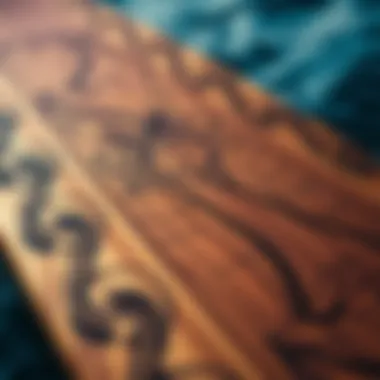
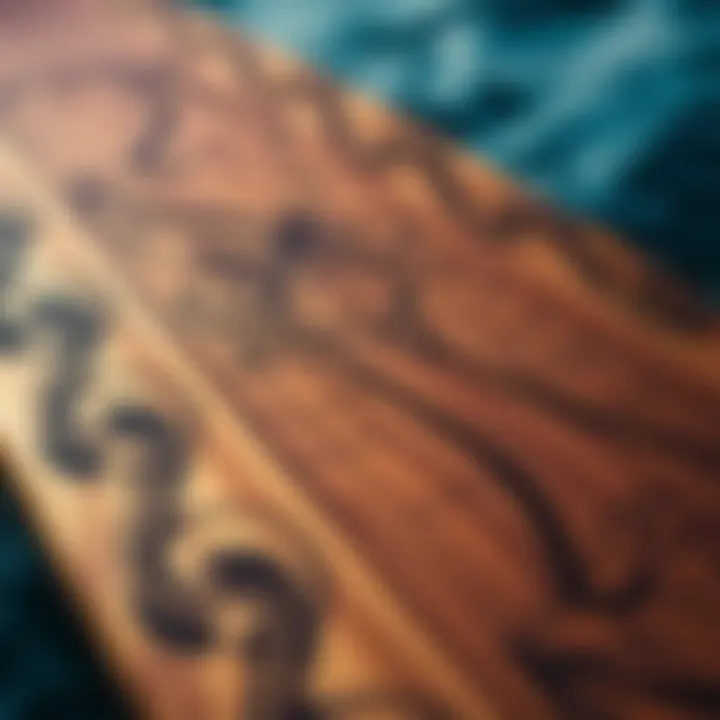
Intro
Wood skimboarding is more than just gliding over the water's surface; it is a dynamic blend of artistry, skill, and culture that invites both seasoned surfers and novices to engage with nature and themselves in a unique way. As you step into the world of skimboards crafted from wood, it becomes clear that this sport is founded upon both the simple joy of riding waves and the intricate details of design, technique, and community.
This guide endeavors to illuminate every facet of wood skimboards, delving into their construction, the types available, and the important techniques that influence performance. The wood choice not only affects the board's responsiveness but also speaks volumes about sustainability and craftsmanship. Beyond the technicalities of skimboarding, we can't overlook the cultural implications this thrilling sport holds for communities around the globe, from sandy beaches to local competitions. Whether you’re a first-timer eager to give it a shot or a veteran riding the waves, understanding the nuances outlined in this guide will serve you well.
As we navigate through the ins and outs of wood skimboards, expect to find detailed insights not just into gear and skills but about the very lifestyle that surrounds skimboarding. This journey is as much about the board you ride as it is about the people you share it with. Gear up, and let's explore this captivating aspect of watersports together!
Gear and Equipment
Types of Wood Skimboards
When discussing gear specifics, the first consideration should be the various types of wood skimboards available. Each has its own character, making it crucial to understand the differences:
- Plywood: Lightweight and often more budget-friendly. Suitable for beginners as they offer decent flexibility and ease to maneuver.
- Hardwood: Provides durability and a smoother ride. Usually favored by more experienced riders for enhanced performance.
- Bamboo: An eco-friendly option that combines strength with flexibility, ideal for those who want sustainability combined with performance.
Choosing the right type of wood not only influences how you'll skim but also reflects your personal values, particularly regarding environmental considerations.
Essential Accessories for Every Skimboarder
Every skimboarder should have certain essentials to enhance their experience:
- Skimboard Wax: This increases grip when skimming, especially on wet surfaces. Types of wax vary based on water conditions and rider preferences.
- Board Bag: Useful for storing and transporting your board safely.
- Water Shoes: Provide grip and protection against the rough surfaces of beaches or rocky shorelines.
- Leash: Attaches your board to your ankle, preventing it from drifting away after a wipeout.
"Your equipment can make a significant difference in how well you perform, making it worth the investment in quality gear."
Understanding these aspects is essential because investing in proper gear can greatly improve both skill level and enjoyment of the sport.
Intro to Wood Skimboards
Understanding wood skimboards provides a gateway to appreciating both the intricacies of design and the thrill of performance. This journey into wood skimboarding is not just about the board itself; it also encompasses the broader culture and community that surrounds this engaging water sport. Exploring wood skimboards enhances one’s grasp of this activity, making the experience richer for enthusiasts of all skill levels.
Definition and Overview
In simplest terms, a skimboard is a flat board that one rides on the surface of the water, typically in coastal areas where water meets sand. Unlike surfing, skimboarding allows individuals to ride in shallow water, launching off the wet sand and gliding back with the waves. Wood skimboards stand out for their unique aesthetic and flexible dynamics. Made primarily from various types of wood, these boards offer an excellent balance between weight and sturdiness. Different boards have different shapes and sizes – important factors that can affect performance.
The essence of wood skimboards lies in their construction. The material used contributes to the board’s buoyancy, how it carves through the water, and its overall durability. This craftsmanship not only enhances the functionality of the skimboard but also connects riders to a heritage of outdoor sport that is deeply rooted in coastal culture.
Historical Context of Skimboarding
Skimboarding’s origins date back to the late 1920s in California, where early surfers sought a new way to catch waves. Initially, skimboards were crafted from solid wood, often constructed out of cedar or redwood. Over the decades, as surf culture blossomed, skimboarding evolved alongside it, shifting from a recreational pastime to a competitive sport.
The late '60s and early '70s saw skimboarding gain traction as a subculture, with dedicated events and communities forming in surf-centric locales. Tracking meticulously through its evolution, one can see the transition from wood-planked iterations to modern materials, like fiberglass. However, there’s a growing resurgence and a nostalgic fondness for wood because of its connection to the roots of skimboarding.
"In every sweep across the shoreline, skimboarders revive stories of adventure and connection with nature."
By understanding the history and definition of wood skimboards, readers can appreciate not only the technical aspects but also the cultural significance embedded in every ride.
Types of Wood Used in Skimboards
Understanding the types of wood utilized in skimboards is crucial for enthusiasts and novices alike. The right wood can significantly affect the board's performance, durability, and overall riding experience. It’s not just about the look; it is about how these boards interact with the waves and the rider. Different woods have different characteristics—some are lighter and provide speed, while others offer sturdiness and resilience.
Popular Wood Varieties
- Plywood
Plywood is the go-to choice for many skimboard manufacturers due to its flexibility and price-effectiveness. Made from layers of wood veneer, it can endure dings and dents while offering a decent stiffness-to-weight ratio. It's perfect for beginners wanting to learn the ropes without breaking the bank. - Marine Grade Plywood
If you’re in for the long haul, marine grade plywood is worth the investment. This type is often treated to resist water damage, making it ideal for frequent water exposure. It offers both durability and performance, allowing advanced riders to push their limits without worrying about their board falling apart. - Bamboo
Known for its sustainability, bamboo is a fantastic option for eco-conscious riders. It's lightweight yet strong, giving excellent maneuverability without compromising on performance. Bamboo skimboards can be a real crowd-pleaser at local beaches, thanks to their unique look and environmental benefits. - Cedar
Cedar is another well-liked material, valued for its buoyancy and natural resistance to rot. Though heavier compared to other woods, its sturdy nature allows for aggressive riding styles. A cedar board can last a long time if properly maintained, making it a solid choice for seasoned skimboarders. - Redwood
This wood is a rarity in the skimboarding world due to its weight and hardness. However, if you’re looking for a stable platform for tricks and flips, redwood boards may indeed be your best bet. Their unique grain and rich color also make them aesthetically pleasing, appealing to those who value craftsmanship.
Sustainable Wood Practices
The importance of sustainability in wood sourcing cannot be stressed enough. As skimboarding grows in popularity, so does the responsibility to ensure that the materials used are ethical and sustainable.
- Sourcing from Certified Forests
When possible, opt for wood that comes from sustainably managed forests. Organizations like the Forest Stewardship Council (FSC) offer certification that ensures responsible forest management practices. This means that the wood is harvested while maintaining the biodiversity and environmental health of the area. - Recycled Woods
Using reclaimed wood is another innovative approach that's gaining traction. Skimboards made from re-purposed materials can carry unique stories and reduce waste, making them appealing for environmentally conscious surfers. Each board crafted from reclaimed wood has its distinctive flaws, which adds character and charm. - Local Sourcing
Choosing wood sourced locally not only supports the community but also reduces the carbon footprint associated with shipping materials over long distances. Local wood often has properties better suited for the climatic conditions where the boards will be used, enhancing the riding experience.
"Choosing the right wood for skimboards is not just about performance; it's also about respecting the environment and supporting sustainable practices."
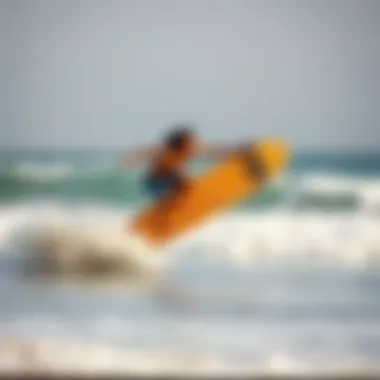
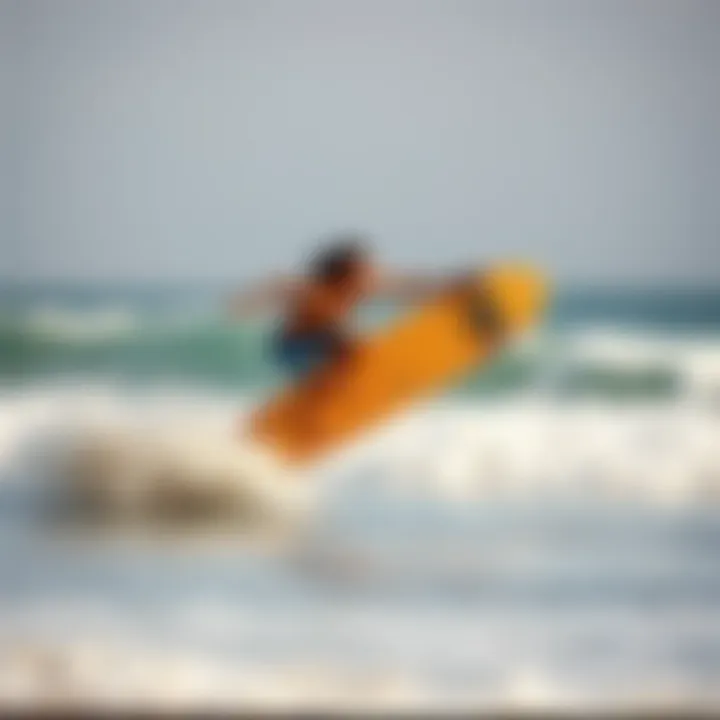
By focusing on these sustainable practices, skimboard makers can maintain a balance between passion for the sport and responsibility towards our planet. In turn, this sets a precedent for future generations of skimboarders to cherish the ocean and land alike.
For more insights into sustainable wood practices, visit USDA's Forest Service or check the comprehensive guide at Sustainable Forestry Initiative.
With a clearer understanding of wood varieties and sustainable sourcing, skimboard enthusiasts can make informed decisions that enhance their experience in this exhilarating sport.
Design Elements of Wood Skimboards
The design of a wood skimboard plays a crucial role in determining its overall performance and how enjoyable it is to ride. A well-considered design not only influences how a skimmer interacts with the water but also reflects the individuality of the rider. In this section, we’ll explore several key elements that contribute to the design of wood skimboards, including shape and size variations, construction techniques, and the finishes that enhance durability. Each element carries significant weight in the overall functionality and aesthetic of the board.
Shape and Size Variations
The shape and size of a skimboard can dramatically affect how it handles during rides. When selecting a skimboard, understanding the various configurations can set one on the right path. A traditional skimboard often features a thinner profile, allowing for better maneuverability, while a thicker board provides more buoyancy.
Key Shapes to Consider:
- Classic Shape: Often characterized by its round edges and wider belly. This style is excellent for beginners, providing stability.
- Fish Tail: This variant is popular among more adventurous riders, enabling sharp turns and quick maneuvers.
- Squash Tail: This style offers a good balance between stability and agility, ideal for intermediate skimmers who want to improve.
In terms of size, a longer board can provide increased glide and stability, making it easier to learn on. Conversely, shorter boards enable better tricks and quicker turns. Most riders choose a board based on their weight and height, as personal comfort directly correlates with performance.
Construction Techniques
Crafting a wood skimboard involves a blend of artistry and engineering. The construction techniques employed can dictate the durability and flexibility of the board. For instance, many premium boards are constructed using layers of plywood, bonded together for strength while still allowing enough flex for performance.
Common Methods Include:
- Laminating: This technique fuses multiple layers of wood providing resilience while keeping the board lightweight.
- CNC Shaping: Computer Numerical Control (CNC) machines can create precision shapes, ensuring a consistent product that adheres to performance standards.
- Hand Finishing: Many artisanal boards are hand-finished. This method can enhance aesthetics but also contribute to a unique feel during rides.
The attention to detail in the construction phase reveals how a skimboard is not merely a tool for recreation, but an object of craftsmanship with a personality. Choosing a board built through meticulous methods often resonates with dedicated skimboarders, who appreciate the unique ride each board offers.
Finishes and Durability
Finishing touches on a wood skimboard are as important as the initial build. A good finish not only protects the wood from wear and tear but enhances the visual appeal as well. Common finishes include epoxy coatings, which provide a waterproof barrier while maintaining a sleek surface.
Finishing Options:
- Epoxy Resin: This provides a strong, waterproof barrier; it's popular due to its glossy finish and durability.
- Polyurethane: Less durable than epoxy but provides a nice finish and is easier to apply.
- Natural Oiling: Some riders prefer a natural look, opting for oils that nourish the wood while providing minimal waterproofing.
These finishes play a protective role, extending the life of the skimboards significantly. Without the right care, wood skimboards can suffer damage from UV light, sea salt, and moisture. A well-finished board can withstand the elements, giving riders peace of mind as they chase the waves.
"The right skimboard is a combination of personal preference and understanding how each aspect of design influences the riding experience."
In summary, the design elements of wood skimboards encompass an array of factors that all contribute to the skimming experience. Riders must consider their personal style, skill level, and riding conditions to choose a board that meets their needs.
For more about the art and science behind skimboarding, you can look at resources like Wikipedia or Britannica.
Links to skimboarding communities and events can be found on platforms like Reddit and Facebook, where enthusiasts share tips and experiences.
Performance Characteristics
Performance characteristics of wood skimboards play a pivotal role in shaping the rider's experience. When considering a skimboard, understand that these characteristics can vastly influence maneuvers, handling, and overall enjoyment in various conditions. Therefore, it's crucial to delve into the specifics of speed, maneuverability, and handling, ensuring enthusiasts make informed decisions that cater to their personal style and the environment in which they skim.
Speed and Maneuverability
Speed on a wood skimboard is akin to the rush of wind in your hair. The shape and size of the board significantly impact how quickly you can glide across the water. Skimboards designed with a pointed nose tend to cut through the water more efficiently, allowing riders to accelerate swiftly. Conversely, boards with broader noses provide stability but may sacrifice some speed.
Key factors affecting speed include:
- Board Weight: Heavier boards generally require more effort for acceleration.
- Surface Texture: A smooth, polished finish reduces drag, enhancing speed.
- Rider Technique: Proper stance and body positioning enable better speed management.
Maneuverability, on the other hand, reflects a rider's ability to navigate twists and turns with ease. It’s essential for performing tricks and making sharp turns. Skimboards with a wider tail offer more surface area, helping to execute tricks while maintaining balance. In contrast, narrower boards can be more agile, perfect for skimming along waves, but might feel less stable.
Ultimately, finding the right balance between speed and maneuverability boils down to personal preference. As one seasoned rider put it:
"It’s about what feels right under your feet; every board tells a different story.”
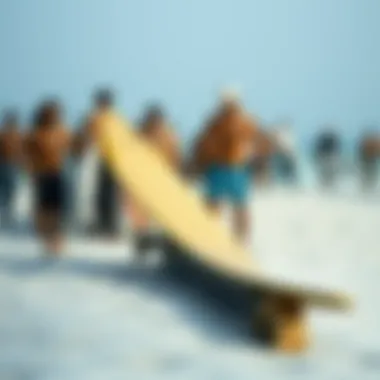
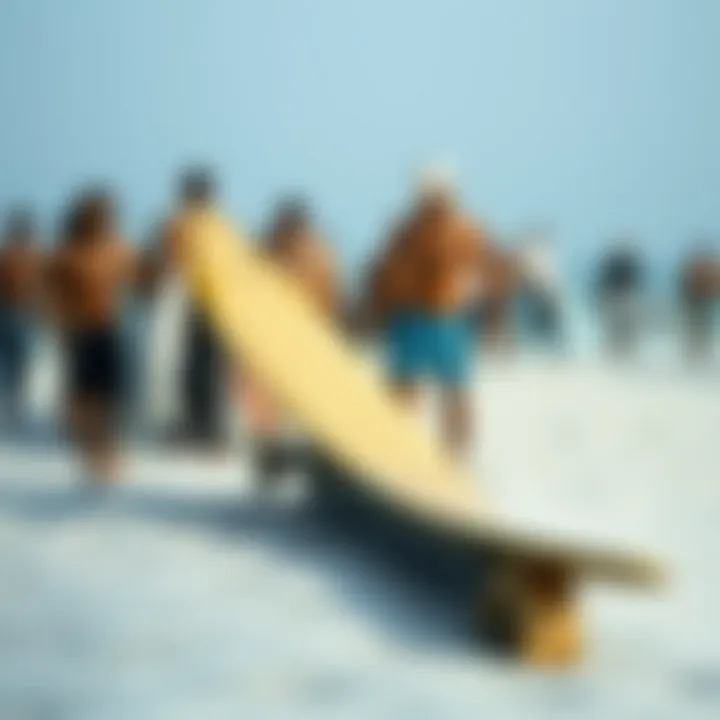
Handling in Different Conditions
Handling a wood skimboard in varied environments is where experience comes into play. Riders need to be cognizant of how their board's characteristics will respond to different conditions, whether it's flat, glassy water or windy, choppy surfaces.
Consider these elements when assessing handling:
- Wave Size and Type: Smaller, gentle waves call for a softer touch and a board that can skim quickly. In contrast, heavy waves necessitate boards built for strength and control.
- Surface Composition: Smooth, packed sand requires less effort in terms of balance and stability, while loose sand demands a firmer grip and more attention to foot placement.
- Wind Conditions: Windy environments can throw off your balance and control. Opting for a heavier board might help keep you grounded when battling gusty conditions.
In addition, how you adapt your technique significantly influences your handling capabilities. For instance, shifting your weight toward the back of the board can facilitate smoother transitions on choppy water. Similarly, leaning into turns rather than away can help maintain flow and momentum, allowing for seamless movement.
In sum, understanding the performance characteristics associated with wood skimboards is crucial for any enthusiast. It not only enhances the experience but also opens the door to exploring different techniques and fun challenges in the dynamic world of skimboarding.
Essential Techniques for Skimboarding
Skimboarding is not just about the board itself; it's also about how you wield it. Mastering essential techniques is the cornerstone of becoming a skilled skimboarder and truly enjoying the experience on the water. This section highlights foundational practices that every rider should know. By honing these techniques, enthusiasts can enhance their performance and confidence, ultimately deepening their connection to this exhilarating sport.
Basic Starting Techniques
Getting off on the right foot—or foot placement, to be exact—is crucial when you first hit the beach with your skimboard. Here are some of the fundamental techniques that set the stage for a successful skimboarding experience:
- Foot Positioning: Start with your feet about shoulder-width apart, and ensure that your back foot is near the tail of the board. Your front foot should rest more towards the center. Adjusting this positioning will give you better control when you begin to move.
- Launching: When you're about to skim, take a few quick steps to build momentum. As you run, start leaning forward slightly—this helps in getting your speed just right as you launch.
- Timing Your Drop: Timing is everything when it comes to placing the board on the water’s surface. As you reach the edge of the wet sand, drop the board behind your front foot as you leap onto it. A clumsy drop might send your board spinning off, so practice this move until it flows naturally.
- Balance: Focus on keeping your weight centered over the board. Bend your knees and lower your center of gravity to improve stability. Like balancing on a seesaw, your balance helps prevent a wipeout.
Practicing these basic starting techniques allows you to enjoy skimboarding with more assurance and less frustration. After all, every expert was once a beginner.
Advanced Tricks and Maneuvers
Once you've nailed the basics, it's time to elevate your skimboarding game. Advanced techniques require not only physical skill but a keen awareness of your surroundings and board dynamics. Here are a few must-try moves:
- Shuvit: This trick involves making the board flip 180 degrees beneath you without actually spinning your body. Approach fast, pop the tail, and slide your foot up to guide the board in the air. Perfecting this will surely impress your friends on the beach.
- 360 Spin: After launching off the water, try spinning your body and board in a full circle. This trick is not just about how fast you can turn; it also demands that you keep an eye on the landing. Timing your rotation with your board’s position is crucial here.
- Flip Tricks: There are various flip tricks to choose from, such as the kickflip or the heel flip. These moves require better foot placement and controlled execution as you leave the water surface. Mastery of flip tricks involves a synchronized motion of foot movement and body weight adjustment.
- Slide Tricks: Slides add style to your tricks. You can attempt tail slides or nose slides by shifting your weight properly and leaning into the move as you engage the board's edge against the surface. Practice makes perfect in this area—don’t hesitate to spend some time just sliding around in the shallow.
Each advanced maneuver challenges not only your physical abilities but also your mental game. The thrill lies in achieving these tricks effortlessly, leaving a lasting impression on yourself and those witnessing your skills.
"Skimboarding is like dancing on water; you have to feel the rhythm of the waves beneath your feet." - A seasoned skimboarding enthusiast.
In summary, mastering these essential techniques sets the groundwork for growth and skill development in skimboarding. Whether you’re conquering basic starting moves or executing advanced tricks, each technique feeds into your larger relationship with the sport. For more information, consider checking out resources on skimboarding techniques on Wikipedia and join community discussions about it on Reddit.
Challenge yourself, and enjoy the ride!
Cultural Perception of Skimboarding
The cultural perception of skimboarding goes far beyond simply riding a board on water's edge. It melds a sense of identity, lifestyle and community. Skimboarding offers something unique, a blend of skill, creativity, and personal expression. The importance of understanding this cultural aspect is crucial for anyone looking to immerse themselves in the sport or grasp its subtleties deeply.
The Skimboarding Community
At its core, the skimboarding community fosters inclusivity. Whether you’re a novice trying to find your footing or a seasoned rider performing jaw-dropping tricks, there's always a place for you among enthusiasts. Various forums and local meet-ups amplify this. Members share tips and tricks, like what wood is best for certain techniques or how to perfect that hard-to-master maneuver.
You could wander over to forums on platforms like reddit.com where skimboarders post challenges, daily experiences or even just seek advice. The camaraderie fairs well in sustaining long-term interest in the sport. The community provides a social backbone that elevates the overall enjoyment of skimboarding, through friendships formed on shared experiences and achievements.
Positive influences cannot be overlooked either. Many up-and-coming skimboarders look up to seasoned pros or influencers who amplify the sport on platforms like Instagram or Facebook, displaying awe-inspiring tricks and showcasing beautiful coastal locations. A major element of the community's culture is inspiring inner growth as much as showcasing external skill.
Event and Competition Scene
Sprinting into the competitive landscape, events and competitions play a huge role in elevating skimboarding as a sport. Well-known contests like the World Skimboard Championship draw participants from various corners of the globe. The adrenaline rush is palpable as competitors showcase their best moves, hoping to outshine one another.
But it’s not just about the competition itself. These events are a celebration of the skimboarding culture. They bring people together, fostering friendships that often last a lifetime. In this melting pot of enthusiasts, there’s an opportunity to discover diverse styles and techniques. Participants get the chance to learn what sets different skimboarders apart.
Moreover, competitions often feature categories that cater to a wide range of skill levels. So whether it’s an amateur showing off a single trick or a professional displaying their repertoire, everyone has a chance to shine.
"Skimboarding is more than just a sport; it’s a way of life, a culture that promotes creativity and community."
Add to this emerging trends, such as eco-friendly competitions with an emphasis on sustainability, and the scene seems only to grow richer. As the sport evolves, so too do the motivations behind it, offering more depth and understanding of what skimboarding truly represents.
In summary, the cultural perception of skimboarding encapsulates much more than riding waves. It includes community ties, shared experiences and a competitive yet friendly environment that collectively represents the heart of this water sport. Engaging with this perspective can vastly enrich one's understanding and appreciation of skimboarding, opening up avenues for new friendships, skills, and maybe even deeper connections with mother nature.
For further exploration of skimboarding culture, sites like en.wikipedia.org offer a wealth of historical context, while dedicated skimboarding community forums and social media pages will keep you engaged with the latest happenings in the scene.
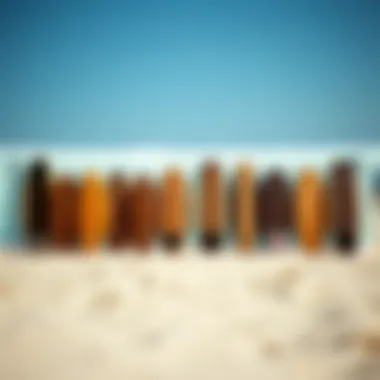
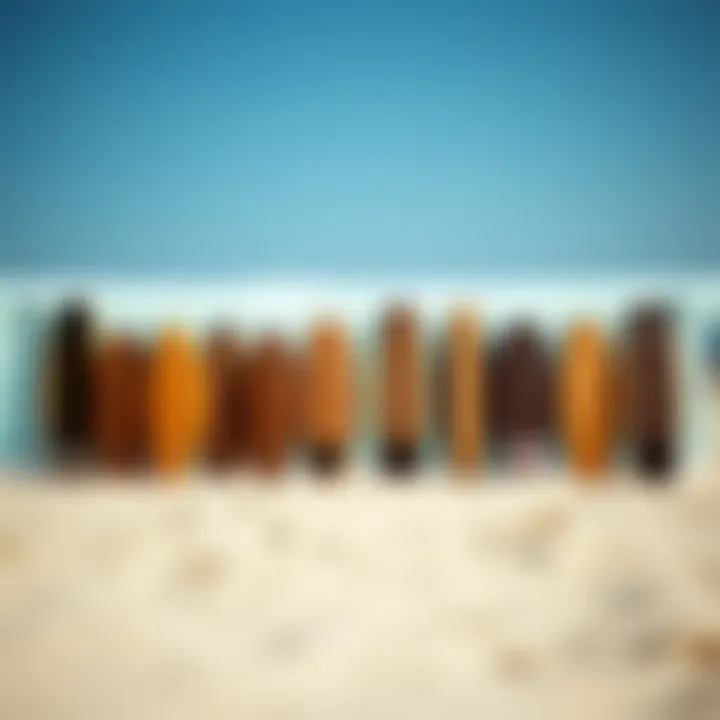
Maintenance and Care of Wood Skimboards
Proper maintenance and care of wood skimboards is crucial for both the longevity of the equipment and the performance on the water. Just like any sporting gear, wood skimboards require attentive upkeep to ensure they stay in top condition. Taking the time to maintain your board not only enhances your skimboarding experience but also upholds the aesthetic appeal of your gear. Neglecting maintenance, on the other hand, can lead to unnecessary wear and tear, which may affect your riding experience.
Maintaining your wood skimboard involves a combination of cleaning, proper storage, and timely repairs. Understanding the nuances of these processes empowers riders to keep their boards in the best shape possible, ensuring they can enjoy their craft to the fullest without interruptions.
Cleaning and Storage Tips
Keeping your wood skimboard clean is more than just a matter of aesthetics; it plays a vital role in its overall health. Here are some cleaning and storage tips to extend the life of your board:
- Cleaning: Use a mild soap solution and a gentle sponge to clean the surface of your skimboard after each use. Be sure to remove any sand, salt, or debris that can accumulate.
- Drying: Always dry your board after use, particularly if you've been in saltwater. Leaving moisture can lead to premature wood rot.
- Storage: Store your skimboard in a cool, dry place, away from direct sunlight. Prolonged exposure to sunlight can cause the wood to warp or the finish to fade. An upright position is ideal for storage, as it prevents pressure on any one part of the board.
Proper care can mean the difference between a board that lasts a few seasons and one that stands the test of time.
- Use a Board Bag: When transporting your skimboard, use a padded board bag to prevent dings and scratches. It acts as a shield during travel.
Repair Techniques for Wood Skimboards
Despite the best upkeep efforts, incidents can occur. Scratches, chips, and even cracks can happen to anyone. Repairing your wood skimboard doesn’t have to be a daunting task. Here are some practical repair techniques:
- Small Dings: For minor scratches or dings, a wood filler can be an effective solution. Apply the filler according to the manufacturer’s instructions, and sand it down to match the board’s surface once it dries.
- Cracks: If you find a crack, clean the area properly and apply a specialized wood glue. Clamp it and let it dry completely before using the board again.
- Finishing Touches: After repairs, consider reapplying the finish to that section to protect it against the elements. A layer of polyurethane can help seal the repaired area and blend it back with the rest of the board.
Maintaining your skimboard is integral not only for performance but also for safety. Engaging in regular care and learning essential repairs can keep you riding waves worry-free.
Comparative Analysis with Alternative Skimboard Materials
Understanding the landscape of skimboarding materials sheds light on the strengths and weaknesses of wood skimboards when lined up against other options like fiberglass or foam. This comparative analysis is pivotal for any skimboard enthusiast, whether a rookie or a seasoned pro, as it informs their choices on materials that align with personal preferences and performance expectations.
Advantages of Wood Skimboards
Wood skimboards carry their own distinctive set of advantages that many users hold in high regard. Here are some key benefits to consider:
- Natural Feel: When it comes to the tactile experience, wood offers a warmth and authenticity unmatched by synthetic materials. Riders often describe the feel of a wooden skimboard as more connected to the water, allowing for nuanced control and response.
- Durability: A well-constructed wood skimboard can withstand considerable wear and tear. Unlike some alternatives that might bow or warp over time, high-quality wood boards resist damage from impacts better, especially on sandy shores.
- Aesthetic Appeal: There’s a certain charm in the natural grain of wood. Many riders appreciate the visual aspect of wood skimboards, often opting for artistic designs and finishes that reflect personal style and creativity.
- Performance in Various Conditions: Wood skimboards generally perform well on a range of surfaces, particularly soft sand and small waves, making them quite versatile. This adaptability is praised by many in the skimboarding community.
- Eco-friendliness: With sustainability becoming a greater concern across sports, wooden boards—especially those sourced from sustainable forests—allow enthusiasts to enjoy the waves while being kinder to the environment.
Disadvantages Compared to Other Materials
However, it’s not all sunshine and rainbows when it comes to wood skimboards. They come with certain drawbacks when pitted against their composite counterparts:
- Weight and Portability: Wooden skimboards tend to be heavier compared to foam or fiberglass models, which can be a hassle for transport. Carrying a solid wooden board from the car to the beach might feel like a bit of a workout.
- Water Absorption: If not properly sealed or maintained, wood skimboards can absorb water. This might lead to swelling and compromised performance over time, particularly if the board sees heavy use in moist environments.
- Cost: High-quality wood skimboards can be on the pricier side compared to other materials. While this often correlates with craftsmanship, it can create a barrier for beginners or those on a budget.
- Limited Tricks Capability: Some advanced riders find that wood skimboards can limit them in executing certain tricks. Their weight and rigidity might not offer the same level of flexibility as lighter foam boards, which are often preferred for high-flying gravity-defying maneuvers.
So, while wood skimboards offer an array of benefits that appeal to many riders, it’s crucial to weigh those against the limitations. In the end, the right choice comes down to personal preferences, riding style, and the conditions one expects to encounter in their skimboarding adventures.
A well-informed skimboarder knows that every material has its place; understanding each can elevate the riding experience to unforgettable heights.
For more information about the craftsmanship behind skimboards, you can check resources like Wikipedia or delve into skimboarding communities on Reddit.
Future Trends in Skimboarding
As the world evolves, so does skimboarding. The trends shaping this sport are not just about flashy designs or new tricks, but they encompass a broader perspective that includes environmental considerations, technological advancements, and cultural transformation. As such, understanding what's on the horizon for skimboarding gives enthusiasts and newcomers insight into where the sport is headed.
With an increasing awareness of sustainability, the shift towards eco-conscious materials and practices is becoming pivotal. This means that skimboard manufacturers are not only concentrating on performance but also the impact their products have on the planet. Eco-friendly woods, water-based finishes, and recyclable components are some innovations that align with these emerging priorities.
Innovations in Design and Materials
Recent years have seen a surge in creativity in the design of wood skimboards. Manufacturers are experimenting with new materials, intricate patterns, and shapes that were once thought impossible. Lightweight composite materials are now being infused with traditional wood grains to enhance performance while retaining the classic aesthetic valued by purists.
Moreover, the design is not just about beauty; it's about function. For instance, asymmetrical boards have gained traction within the skimboarding scene. These boards can offer unique experiences in different conditions and while performing a variety of tricks. Innovations also include using CNC technology for precise shaping, allowing for tailored customization that can meet an individual’s unique riding style and preferences.
One interesting concept that is gaining ground involves the incorporation of responsive elements into the design itself. This could mean integrated sensors that analyze water conditions and board performance, adjusting the shape or buoyancy accordingly. As we look ahead, the potential for smart skimboards could very well redefine how enthusiasts interact with both their boards and their environment.
The Evolving Skimboarding Community
Community plays an undeniably vital role in the growth of any sport, and skimboarding is no different. The culture surrounding skimboarding is evolving, fueled largely by digital platforms allowing skimmers to connect across the globe. Social media platforms, like Instagram and TikTok, are inundated with skimboarding content, allowing new talents to shine and share their unique styles.
Additionally, there’s a growing trend to include a broader range of voices within the skimboarding community. More women and underrepresented groups are stepping into the spotlight, driven by the desire for inclusivity and representation. This is spawning new events and gatherings designed to break down barriers and celebrate diverse talents.
Skimboarding competitions are also adapting to the times. Traditional formats may take a backseat as the focus shifts to creativity and authenticity rather than just skill. Events like the World Skimboarding Championship are increasingly awarding points for originality in tricks, spurring participants to push boundaries and innovate.
"The future isn't what it used to be!"
This quote embodies the ever-changing nature of skimboarding. As new technologies, materials, and cultural movements emerge, the sport will continue to transform. For enthusiasts, staying informed about these trends is crucial, not just to enhance their skills but also to actively participate in a community that is continually shaping its future.







